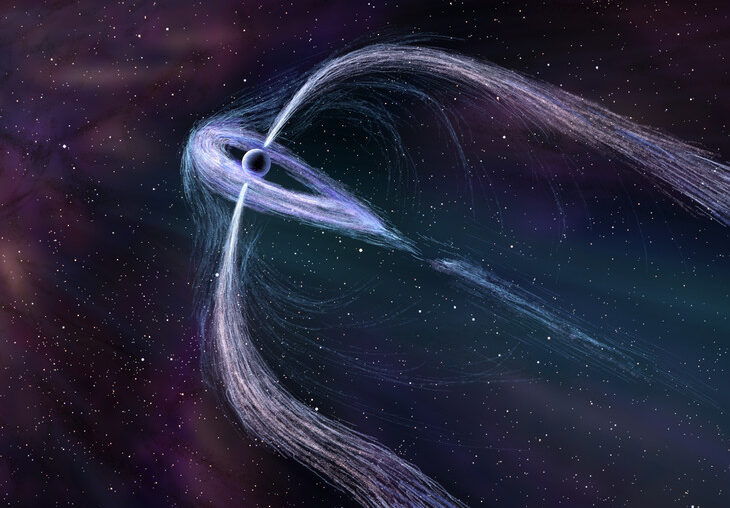
© MPIK / H.E.S.S. Collaboration
Using a telescope in Namibia, astronomers and physicists have discovered extremely energetic electrons among the continuous rain of cosmic rays, the charged particles (mostly protons and electrons) that come from unknown sources in the universe. Some of these electrons carry three times more oomph than can be created by the world’s most powerful particle accelerator: The reported value of 40 tera-electronvolt (TeV) is a record among cosmic ray electrons. These very-high-energy electrons must originate in our own cosmic neighborhood.
One way to detect cosmic rays is by searching for ultra-brief and faint flashes of Cerenkov radiation, produced when these particles interact with Earth’s atmosphere. The High Energy Stereoscopic System (HESS) in Namibia is an array of one 28-meter and four 12-meter “light collectors” that does just that. The brightness of each Cerenkov flash tells you the energy of the incoming cosmic ray particle, but only by statistically studying large data sets is it possible to discern between protons and electrons.
Publishing in Physical Review Letters (preprint available on the arXiv), HESS collaboration scientists present a thorough statistical analysis of 2,728 hours of data obtained between 2003 and 2015. They exclude areas of the sky like the plane of the Milky Way Galaxy that contain known sources of gamma rays, as these energetic photons also produce Cerenkov radiation in our atmosphere. The researchers also use elaborate computer simulations to model the processes in the atmosphere and the response of the telescope’s detectors.
At higher and higher energies, the number of cosmic ray particles drops rapidly, says team member Kathrin Egberts (University of Potsdam, Germany), but this drop is much steeper for electrons than it is for protons. “Around 20 TeV, protons already outnumber electrons by a factor of 100,000,” she says. So to measure electrons of much higher energy, the team must first get rid of the “background” of the much more numerous protons.
In the end, the team was left with 265,574 events that are most likely caused by cosmic ray electrons, with energies between 0.3 and 40 TeV. (The events could also represent positrons, the positively charged antiparticles of electrons, since HESS cannot discriminate between the two.).
“It’s a very difficult analysis,” says high-energy physicist Harm Schoorlemmer (Radboud University, The Netherlands), who was not involved in the study. “It has taken them a long time, but their results look convincing.”

Nahks TrEhnl
What’s interesting about the high-energy electrons is that they must be produced by “local” sources, that is, within at most a few thousand light-years. That’s because the higher energy an electron has, the faster it loses it via interactions with photons or with magnetic fields. Supernova remnants or pulsar wind nebulae are capable of accelerating electrons to TeV energies, says Egberts. But unfortunately, it’s impossible to pinpoint individual sources of these cosmic rays, since cosmic magnetic fields deflect and scramble the paths of charged particles as they travel through space.
Some information, though, can be obtained by looking at the electron spectrum: the precise way in which the number of particles falls off with energy. Above approximately 1 TeV, the amount of electrons drops much more rapidly, a relatively sharp spectral break that the researchers suggest points to a small number of nearby sources, or maybe even just one. If there were more sources, their contributions would have smeared out any prominent spectral features.
Future facilities like the Cerenkov Telescope Array (CTA), which is under construction in northern Chile and on the Canary Islands, might reveal what’s going on, says Schoorlemmer. “CTA will provide much better statistics,” he says, “which makes it much easier to get rid of the proton and gamma-ray background.”

